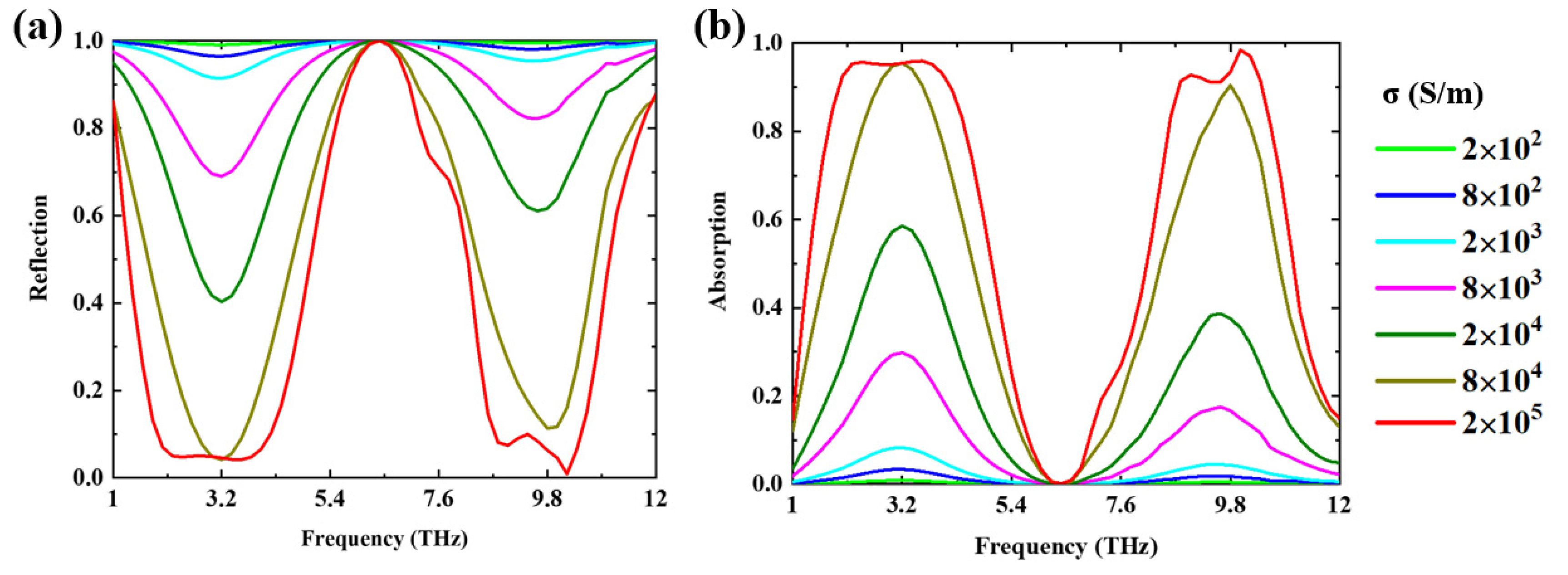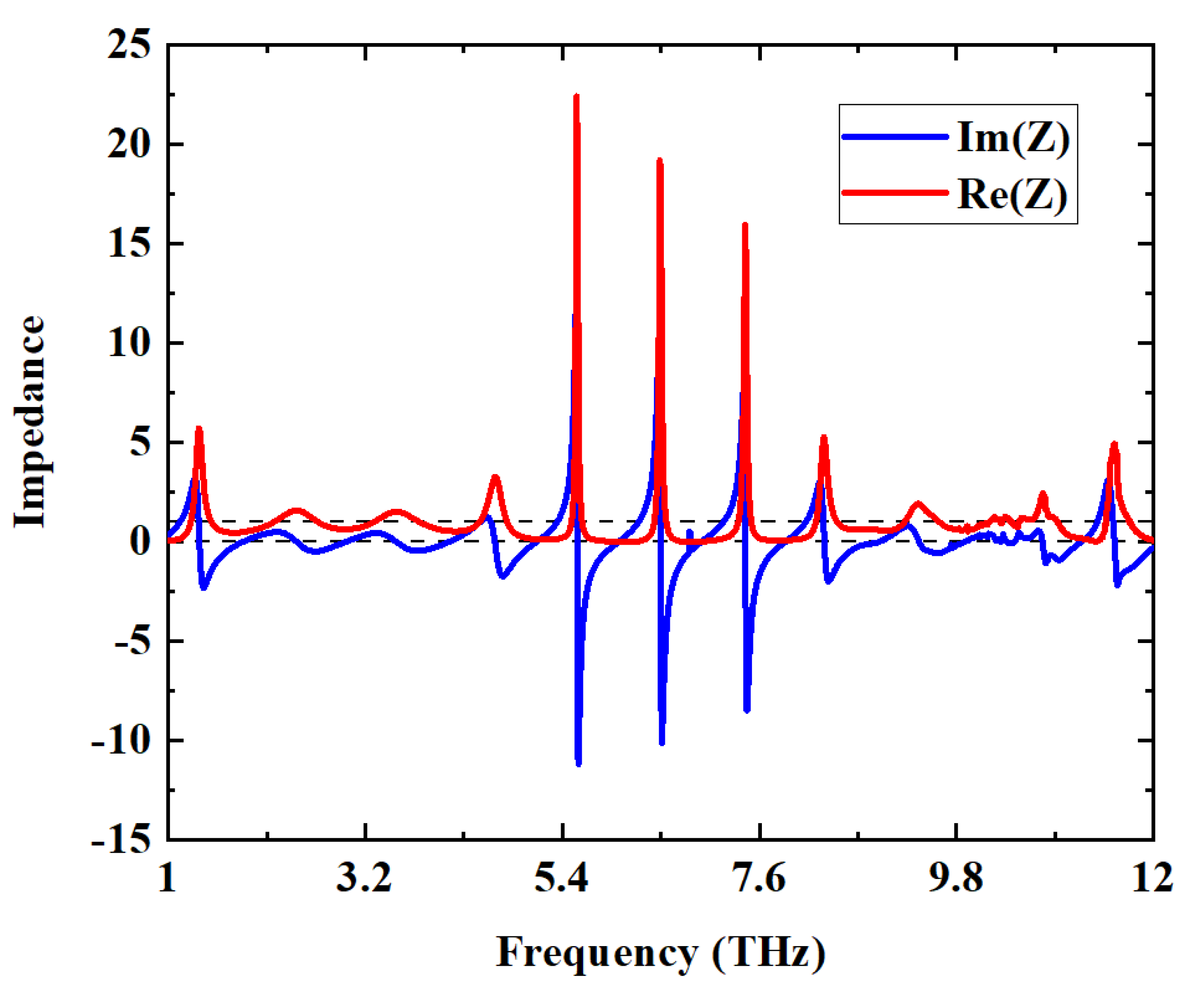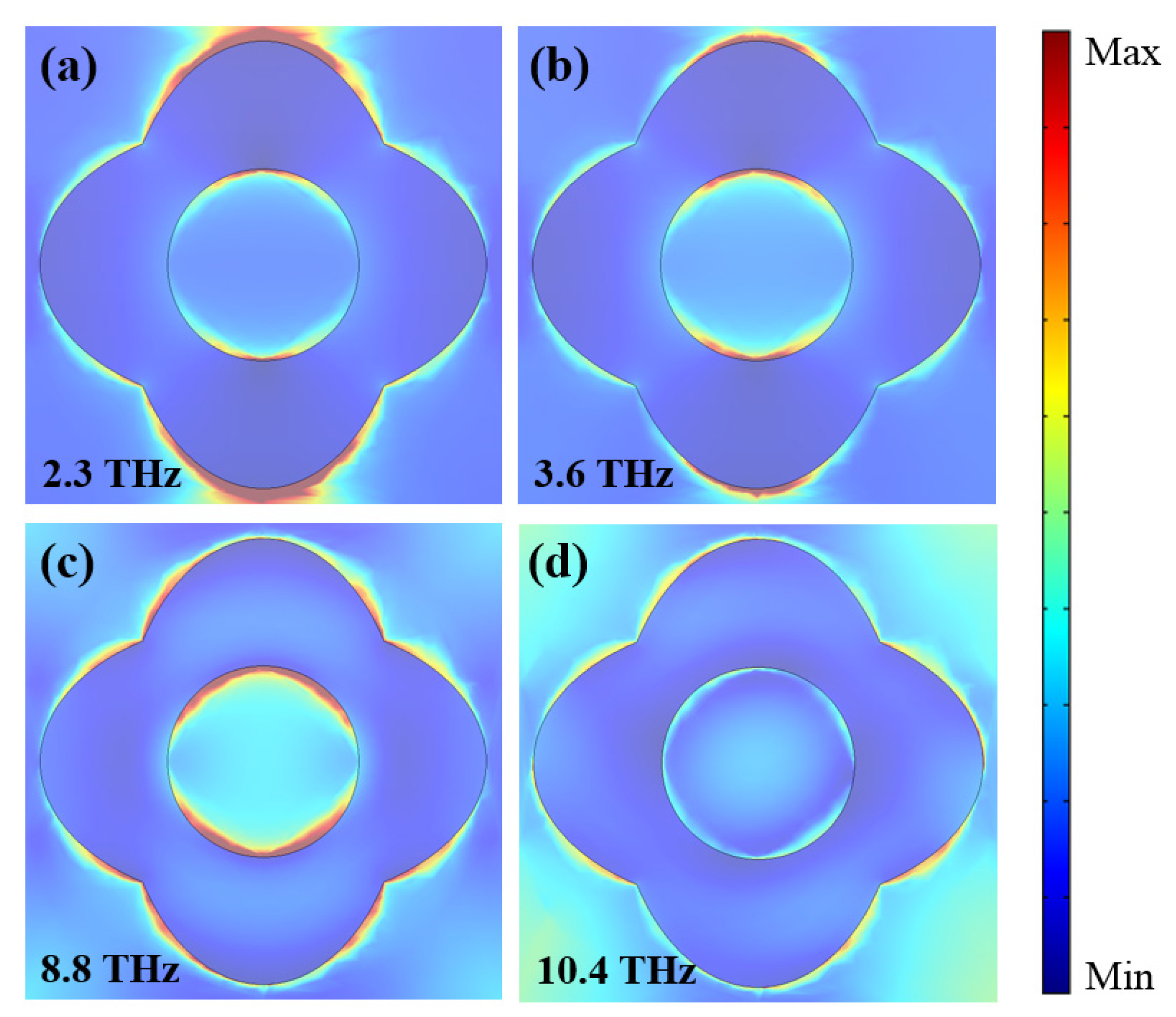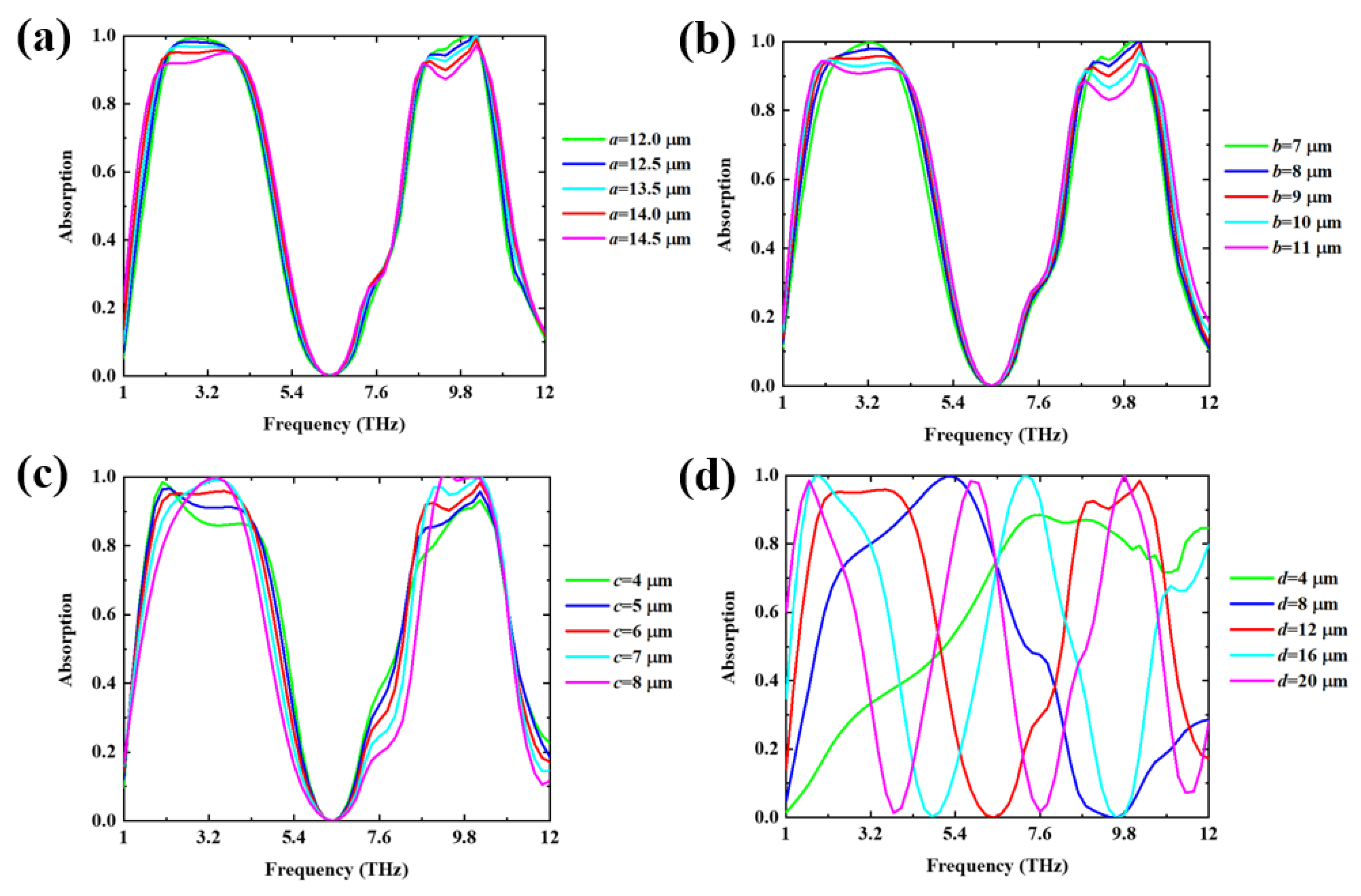Tunable Dual Broadband Terahertz Metamaterial Absorber Based on Vanadium Dioxide
Abstract
1. Introduction
2. Materials and Methods
3. Results
4. Discussion
5. Conclusions
Author Contributions
Funding
Conflicts of Interest
References
- Koenig, S.; Lopez-Diaz, D.; Antes, J.; Boes, F.; Henneberger, R.; Leuther, A.; Tessmann, A.; Schmogrow, R.; Hillerkuss, D.; Palmer, R.; et al. Wireless sub-THz communication system with high data rate. Nat. Photonics 2013, 7, 977–981. [Google Scholar] [CrossRef]
- Woolard, D.L.; Brown, E.R.; Pepper, M.; Kemp, M. Terahertz frequency sensing and imaging: A time of reckoning future applications? Proc. IEEE 2005, 93, 1722–1743. [Google Scholar] [CrossRef]
- Wu, Q.; Hewitt, T.D.; Zhang, X.C. Two-dimensional electro-optic imaging of THz beams. Appl. Phys. Lett. 1996, 69, 1026–1028. [Google Scholar] [CrossRef]
- Yang, C.; Wang, Z.; Yuan, H.; Li, K.; Zheng, X.; Mu, W.; Yuan, W.; Zhang, Y.; Shen, W. All-Dielectric Metasurface for Highly Tunable, Narrowband Notch Filtering. IEEE Photonics J. 2019, 11. [Google Scholar] [CrossRef]
- Zhang, T.; Zhang, J.; Xu, J.; Wang, Q.; Zhao, R.; Liu, H.; Dong, G.; Hao, Y.; Bi, K. Wideband metasurface filter based on complementary split-ring resonators. Mod. Phys. Lett. B 2017, 31, 1750222. [Google Scholar] [CrossRef]
- Liu, Z.; Guo, L.; Zhang, Q. A Simple and Efficient Method for Designing Broadband Terahertz Absorber Based on Singular Graphene Metasurface. Nanomaterials 2019, 9, 1351. [Google Scholar] [CrossRef] [PubMed]
- Wang, Q.; Zhou, R.; Wang, X.; Guo, Y.; Hao, Y.; Lei, M.; Bi, K. Wideband terahertz absorber based on Mie resonance metasurface. Aip Adv. 2017, 7, 115310. [Google Scholar] [CrossRef]
- Quader, S.; Zhang, J.; Akram, M.R.; Zhu, W. Graphene-Based High-Efficiency Broadband Tunable Linear-to-Circular Polarization Converter for Terahertz Waves. IEEE J. Sel. Top. Quantum Electron. 2020, 26, 1–8. [Google Scholar] [CrossRef]
- Xiao, Z.; Zou, H.; Zheng, X.; Ling, X.; Wang, L. A tunable reflective polarization converter based on hybrid metamaterial. Opt. Quantum Electron. 2017, 49, 401. [Google Scholar] [CrossRef]
- Campbell, S.D.; Grobe, S.D.; Goodin, I.L.; Su, Q.; Grobe, R. Limitations of decomposition-based imaging of longitudinal absorber configurations. Phys. Rev. A 2008, 77, 023821. [Google Scholar] [CrossRef]
- Chen, H.; Ma, W.; Huang, Z.; Zhang, Y.; Huang, Y.; Chen, Y. Graphene-Based Materials toward Microwave and Terahertz Absorbing Stealth Technologies. Adv. Opt. Mater. 2019, 7, 1801318. [Google Scholar] [CrossRef]
- Liu, X.; Fu, G.; Liu, M.; Liu, G.; Liu, Z. High-Quality Plasmon Sensing with Excellent Intensity Contrast by Dual Narrow-Band Light Perfect absorbers. Plasmonics 2017, 12, 65–68. [Google Scholar] [CrossRef]
- Landy, N.I.; Sajuyigbe, S.; Mock, J.J.; Smith, D.R.; Padilla, W.J. Perfect metamaterial absorber. Phys. Rev. Lett. 2008, 100, 207402. [Google Scholar] [CrossRef] [PubMed]
- Bhattacharyya, S.; Ghosh, S.; Srivastava, K.V. Triple band polarization-independent metamaterial absorber with bandwidth enhancement at X-band. J. Appl. Phys. 2013, 114, 094514. [Google Scholar] [CrossRef]
- Cong, L.; Tan, S.; Yahiaoui, R.; Yan, F.; Zhang, W.; Singh, R. Experimental demonstration of ultrasensitive sensing with terahertz metamaterial absorbers: A comparison with the metasurfaces. Appl. Phys. Lett. 2015, 106, 031107. [Google Scholar] [CrossRef]
- Watts, C.M.; Liu, X.; Padilla, W.J. Metamaterial Electromagnetic Wave Absorbers. Adv. Mater. 2012, 24, OP98–OP120. [Google Scholar] [CrossRef] [PubMed]
- Chen, K.; Adato, R.; Altug, H. Dual-Band Perfect Absorber for Multispectral Plasmon-Enhanced Infrared Spectroscopy. Acs Nano 2012, 6, 7998–8006. [Google Scholar] [CrossRef]
- Cao, T.; Wei, C.-W.; Simpson, R.E.; Zhang, L.; Cryan, M.J. Broadband Polarization-Independent Perfect Absorber Using a Phase-Change Metamaterial at Visible Frequencies. Sci. Rep. 2014, 4, 3955. [Google Scholar] [CrossRef]
- Hedayati, M.K.; Zillohu, A.U.; Strunskus, T.; Faupel, F.; Elbahri, M. Plasmonic tunable metamaterial absorber as ultraviolet protection film. Appl. Phys. Lett. 2014, 104, 041103. [Google Scholar] [CrossRef]
- Hedayati, M.K.; Faupel, F.; Elbahri, M. Tunable broadband plasmonic perfect absorber at visible frequency. Appl. Phys. Mater. Sci. Process. 2012, 109, 769–773. [Google Scholar] [CrossRef]
- Andryieuski, A.; Lavrinenko, A.V. Graphene metamaterials based tunable terahertz absorber: Effective surface conductivity approach. Opt. Express 2013, 21, 9144–9155. [Google Scholar] [CrossRef]
- Wang, R.; Li, L.; Liu, J.; Yan, F.; Tian, F.; Tian, H.; Zhang, J.; Sun, W. Triple-band tunable perfect terahertz metamaterial absorber with liquid crystal. Opt. Express 2017, 25, 32280–32289. [Google Scholar] [CrossRef]
- Pu, M.; Wang, M.; Hu, C.; Huang, C.; Zhao, Z.; Wang, Y.; Luo, X. Engineering heavily doped silicon for broadband absorber in the terahertz regime. Opt. Express 2012, 20, 25513–25519. [Google Scholar] [CrossRef] [PubMed]
- Wen, Q.-Y.; Zhang, H.-W.; Yang, Q.-H.; Xie, Y.-S.; Chen, K.; Liu, Y.-L. Terahertz metamaterials with VO2 cut-wires for thermal tunability. Appl. Phys. Lett. 2010, 97, 021111. [Google Scholar] [CrossRef]
- Song, Z.; Wang, K.; Li, J.; Liu, Q.H. Broadband tunable terahertz absorber based on vanadium dioxide metamaterials. Opt. Express 2018, 26, 7148–7154. [Google Scholar] [CrossRef]
- Bai, J.; Zhang, S.; Fan, F.; Wang, S.; Sun, X.; Miao, Y.; Chang, S. Tunable broadband THz absorber using vanadium dioxide metamaterials. Opt. Commun. 2019, 452, 292–295. [Google Scholar] [CrossRef]
- Huang, J.; Li, J.; Yang, Y.; Li, J.; Ii, J.; Zhang, Y.; Yao, J. Active controllable dual broadband terahertz absorber based on hybrid metamaterials with vanadium dioxide. Opt. Express 2020, 28, 7018–7027. [Google Scholar] [CrossRef]
- Wang, S.; Kang, L.; Werner, D.H. Hybrid Resonators and Highly Tunable Terahertz Metamaterials Enabled by Vanadium Dioxide (VO2). Sci. Rep. 2017, 7, 1–8. [Google Scholar] [CrossRef]
- Naftaly, M.; Miles, R.E. Terahertz time-domain spectroscopy of silicate glasses and the relationship to material properties. J. Appl. Phys. 2007, 102, 043517. [Google Scholar] [CrossRef]
- Smith, D.R.; Schultz, S.; Markos, P.; Soukoulis, C.M. Determination of effective permittivity and permeability of metamaterials from reflection and transmission coefficients. Phys. Rev. B 2002, 65, 195104. [Google Scholar] [CrossRef]
- Song, Z.; Jiang, M.; Deng, Y.; Chen, A. Wide-angle absorber with tunable intensity and bandwidth realized by a terahertz phase change material. Opt. Commun. 2020, 464, 125494. [Google Scholar] [CrossRef]






Publisher’s Note: MDPI stays neutral with regard to jurisdictional claims in published maps and institutional affiliations. |
© 2020 by the authors. Licensee MDPI, Basel, Switzerland. This article is an open access article distributed under the terms and conditions of the Creative Commons Attribution (CC BY) license (http://creativecommons.org/licenses/by/4.0/).
Share and Cite
Jiao, X.-F.; Zhang, Z.-H.; Li, T.; Xu, Y.; Song, G.-F. Tunable Dual Broadband Terahertz Metamaterial Absorber Based on Vanadium Dioxide. Appl. Sci. 2020, 10, 7259. https://doi.org/10.3390/app10207259
Jiao X-F, Zhang Z-H, Li T, Xu Y, Song G-F. Tunable Dual Broadband Terahertz Metamaterial Absorber Based on Vanadium Dioxide. Applied Sciences. 2020; 10(20):7259. https://doi.org/10.3390/app10207259
Chicago/Turabian StyleJiao, Xiao-Fei, Zi-Heng Zhang, Tong Li, Yun Xu, and Guo-Feng Song. 2020. "Tunable Dual Broadband Terahertz Metamaterial Absorber Based on Vanadium Dioxide" Applied Sciences 10, no. 20: 7259. https://doi.org/10.3390/app10207259
APA StyleJiao, X.-F., Zhang, Z.-H., Li, T., Xu, Y., & Song, G.-F. (2020). Tunable Dual Broadband Terahertz Metamaterial Absorber Based on Vanadium Dioxide. Applied Sciences, 10(20), 7259. https://doi.org/10.3390/app10207259



